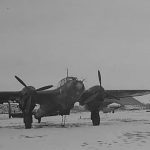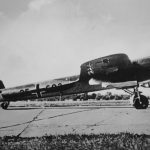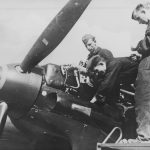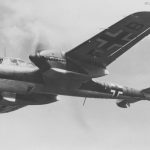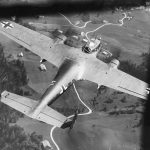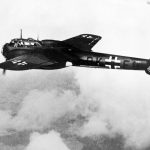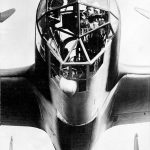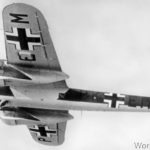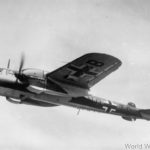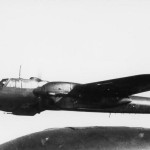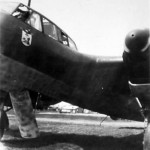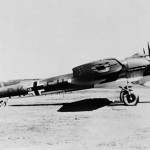Night fighter Do 215B-5 of NJG 2, Holland
Do 215 V-3 25-C03
Do215 V-3
Do215 engine
Do215 NO-TB
Do215 NO-TB
Do 215 PK-EQ
Do 215 nose
Do 215 2
Aerial reconnaissance aircraft Do 215B-4 PK+EM in flight
Dornier Do 215B-1 W.Nr. 0048 NO+TB in flight 1940
Dornier Do 215B-1 in flight 1940
Prototype Do 17S-01 D-AFFY, 1938
Do 215B-1 W.Nr. 0048 NO+TB in flight 1940 2
Dornier Do 215B
Dornier Do 215 cockpit interior
Crashed Dornier Do 215
Dornier Do 215 B-4 front view Smolensk 1941
Night fighter Dornier Do 215 B-5 Kauz III, code R4+SN of NJG 2 in flight 1942
Dornier Do215 B-1
Dornier Do 215 “The Flying Pencil” in flight
Dornier Do 215 B-1
Dornier Do 215 B-4 reconnaissance aircraft
Bomber and reconnaissance aircraft Dornier Do 215 was the “younger brother” bomber Do 17. Do 215 kept the basic design solutions of “flying pencil”, but was powered by inline engines Daimler-Benz DB601 Aa.
Due to the sensation that the Dornier Do 17 had caused at an air show in Zurich in the summer of 1937, numerous countries began to take an interest in the type. Yugoslavia acquired a production licence for the Do 17K and Do 17M versions. In the meantime, a new version for the Luftwaffe, the Do 17Z, went into production but was not licensed for export. Dornier soon made efforts to obtain such approval. RLM finally allowed the export under the condition of a deviating designation Do 215.
As before, Yugoslavia was the first interested party. A pre-production Do 17 Z-0 was fitted with a pair of Gnôme-Rhône 14N radial engines as a demonstration aircraft and was given the designation Do 215 V2 before being presented to the Yugoslavian Air Force. Previously, a Do 17 Z-0 with the standard BMW Bramo 323A-1 engines had been redesignated the Do 215 V1. However, the V2 showed little improvement in flight characteristics over its predecessor, which was already in production in Yugoslavia, so no order was placed. Dornier then decided to equip the Do 215 with the more powerful DB-601A engines made by Daimler-Benz. A corresponding prototype flew under the designation Do 215 V3 and showed considerable increases in performance compared to the other prototypes.
In December 1939, Sweden ordered 18 Do 215 A-1s to replace the undelivered French Breguet 694s, but the ordered aircraft were not delivered due to a German export embargo and the order was subsequently cancelled in September 1940. The German Luftwaffe took delivery of the aircraft instead.
In 1941, some Do 215Bs received the armament head already mounted in the Do 17 Z-10 “Kauz II” instead of the nose glazing for night fighter purposes. These aircraft were given the designation Do 215 B-5. At least 17 aircraft were converted into such night fighters.
Dornier Do215 were used in combat by Germans and Hungarians. Three aircraft of this type were sold to the USSR. Number built: 101.
Bibliography
- David Donald: Warplanes of the Luftwaffe, Barnes and Noble 1994
- Manfred Griehl: Dornier Do-17 E-Z, Do 215 B – The Flying Pencil in Luftwaffe Service
- Christopher F. Shores: Luftwaffe Fighter, Bomber & Marine Camouflage & Markings 1940 Volume 2 – Bf110 – Ju87 – Fw200 – He59 – He115 – Do215 – Do18 – Do24 – Ar196, Osprey Aircam Aviation Series №S11
- Heinz J Nowarra: The Flying Pencil, Schiffer Military History
- Manfred Griehl: Dornier Bombers and Reconnaissance Aircraft 1925-1945, Warbirds Fotofax, Arms & Armour Press 1990
- Marek J. Murawski: Dornier Do 17/Do 215, Kagero Monographs 60
- David Wadman, John Bradley: Aufklarer – Luftwaffe Reconnaissance Aircraft & Units 1935-1945, Hikoki Publications, 1997
- J.R. Smith, Antony L. Kay – German Aircraft of the Second World War, Putnam 1990
- J. Richard Smith: The Dornier Do 17 & 215, Aircraft Profile 164
- Samoloty Luftwaffe 1933-1945 Tom I & II – Marek Murawski, Ilustrowana Encyklopedia Techniki Wojskowej (polish)
